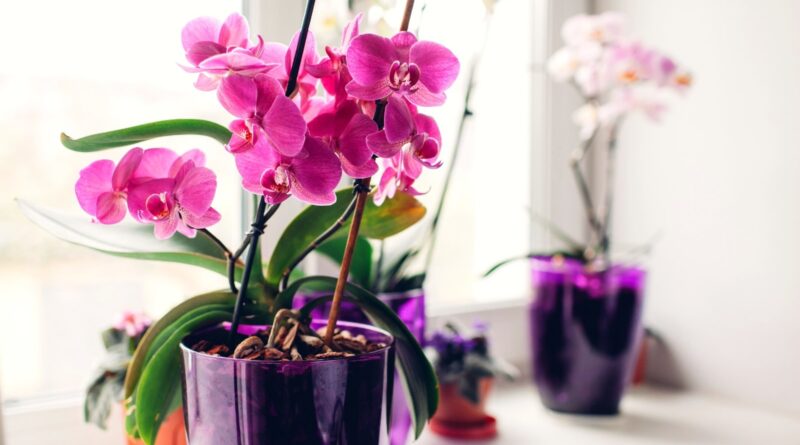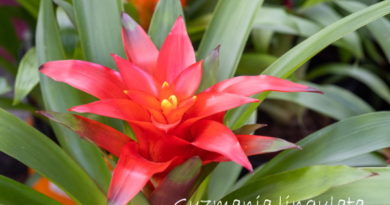How and When To Fertilize Orchids
Orchids are known for being a bit fussy when it comes to their care and keeping. While the degree of difficulty varies between genres, one thing is for certain. Orchids are not plants you can set on a shelf, forget about, and still expect to bloom.
Coaxing an orchid to bloom takes just the right temperature and shifts in temperature, light, water, and, perhaps most importantly, fertilizer. Orchids are considered heavy feeders. They don’t have potting soil to draw nutrients from, and the bark that they are typically planted in doesn’t hold onto much, so it is important to be vigilant about getting these plants the nutrients that they need if you want them to perform.
The Importance of Fertilizer

Fertilizer plays different roles in plant growth, flower development, and root development. The ratio of nutrients in the fertilizer determines what factors it will contribute most to. When we talk about fertilizer nutrients, we mainly reference the macronutrients. These are nitrogen, phosphorus, and potassium, denoted by the letters N-P-K.
To determine the makeup of a particular fertilizer, look at the numbers listed that represent these three macronutrients. For example, a fertilizer with a ratio of 10-10-10 has a balance of the same quantity of all three macronutrients. Each of these nutrients plays a specific role in plant development.
Nitrogen

Nitrogen is a major component in the process of photosynthesis. Without nitrogen, a plant will lack chlorophyll, which might manifest as yellowing leaves. It also helps the roots regulate nutrient and water uptake and provides energy for the plant to continue growing.
Phosphorus

Phosphorus also plays a role in photosynthesis, helping to store and transfer energy throughout the plant. More importantly, it plays a key role in flower production and is vital for plant seed development in most flowering plants; this fuels flowering and fruiting in most species of flowers. It helps in the process of metabolizing sugars, cell division, and cell growth. Phosphorus is also responsible for the development of roots, making it a vital aspect of fertilizing flowering plants.
Potassium

Potassium helps the water and nutrients move through plant tissues, ensuring that the food the plant uptakes goes to where it is most needed. It is a crucial player in healthy root formation and is involved in enzyme activation within plant tissues. It also helps the plant deal with stressors like shifts in temperature, insect infestation, and disease.
In Phalaenopsis orchids, studies indicate that potassium is vital to leaf integrity during and after flowering. Plants that received lower potassium levels often had discolored leaf tips early after the flower stem began to form, gradually declining. In the absence of potassium in the soil, the plant was dead soon after flowering subsided. Interestingly, plants that were provided with a potassium fertilizer were reported to have longer flower stems with slightly larger flowers than those that lacked the fertilizer. The plant’s health due to the potassium likely played a key role.
Fertilizer is even more important when dealing with potted and container plants, as their soil has limited resources. Fertilizer is vital for orchids, usually potted in a very loose bark mix.
Do All Orchids Need Fertilizer?

Yes. Orchids like to be fertilized and have species-dependent needs. The reason for this lies, again, in the potting medium. Orchids have very sensitive roots. As mostly epiphytic or lithophytic plants, their roots do not do well when they are planted in conventional potting soil.
In nature, these plants grow in trees or from rocks, with their rather substantial root systems exposed to the air. They receive nutrients from the air, by way of humidity, and by the rainwater that trickles through the trees overhead.
If you live in a tropical climate and keep your orchids outdoors, growing them in and under trees, you may be able to reduce fertilizing in some cases. In most other cases, though, these plants must be given a fair amount of fertilizer.
Types of Fertilizer

Walking into a nursery and perusing the fertilizer aisle can be daunting. There are many different formulas, ratios, and ingredients in these products, and it can be difficult to choose just one when they all seem like they would help your plant in one way or another.
There are organic and synthetic fertilizers, liquid or granular formulas, and compound or slow-release fertilizers. Organic fertilizers can be made from many things, such as bat guano, manure, compost, and even bone or blood meal.
Choosing the Right Formula
Usually, orchids do best with a water-soluble synthetic formula instead of an organic granular variety. Powdered formulas are often easiest to dissolve in water at the right ratio for your species of orchid.
Nitrogen is important for orchids as they use it for healthy leaf development. Some growers use a higher-nitrogen fertilizer in the early stages of plant development just to fuel that leafy growth.
However, the Senior Curator of Orchids at the New York Botanical Garden recommends a balanced formula such as a 20-20-20 in a powdered form. This balanced formula should supply all the nutrients your plant needs.
There are plenty of specialty orchid fertilizers that are available commercially. These are made to address the specific needs of orchids and can also work well to give your plant what it needs. These vary greatly in their NPK ranges and can be very confusing, as some formulations have a high N, others with a high P, and still more with a high K.
Read the packaging from the manufacturer if selecting a specialty orchid fertilizer and determine if it meets your plant’s needs. In many cases, it may not be ideal for your exact species, and going with the balanced formula will be easiest.
When and How Often Do Orchids Need Fertilizer?

During the dormant period after blooming and the growth period leading up to blooming, fertilize your orchid about once every other week. Because their potting medium does little to hold onto fertilizer, orchids must be fertilized frequently, especially during their growing season. Orchids usually do most of their growing in the summer. Their bloom time determines whether this time overlaps more into the spring or fall.
Here, the best method is to err on the lighter side when necessary. Orchids can become overfertilized, and many are sensitive to excesses of salt. Fully rinsing the root system at least once per month can reduce the risks of salt exposure.
A general rule of thumb often recommended is to “fertilize weakly, weekly.” However, orchids have varied needs depending on their species.
Species-specific Recommendations
We suggest following the recommendations suggested by the New York Botanical Garden (using a balanced, 20-20-20 water-soluble fertilizer):
- Paphiopedilum: Diluted to 1/4 strength, given to the plant every other time you water. Reduce to once per month in the winter.
- Phalaenopsis: Diluted to 1/4 strength, given to the plant every time or every other time you water, with regular root rinses (at least once monthly, or more often if desired). Feed year-round for this species.
- Miltoniopsis: Diluted to 1/4 strength, given to the plant every other week. This species is particularly salt-sensitive and may need more frequent root rinses; flush 1-2 times a month at minimum. Reduce fertilizing frequency in the winter.
- Cattleya: Diluted to 1/4 strength, given to the plant every other week. Weekly feeding is not necessary. Feed year-round for this species.
- Oncidium: Diluted to 1/4 strength, given to the plant once or twice a month. Flush roots at least once per month. Fertilizing this species year-round will enhance flower formation.
- Vanda: Diluted to 1/4 or 1/2 strength, given to the plant each time you water. Vanda has a greater need for nutritional supplements than most orchids. Reduce fertilizing frequency in the winter.
- Dendrobium (hard cane): Diluted to 1/2 strength, given to the plant every other time you water. Hard cane dendrobiums need more nutritional supplementation than most orchids. Reduce frequency in the winter.
Outdoor orchids will commonly need to be watered more often than those kept indoors. Increased airflow and heat mean the potting medium dries out faster, so you may water an outdoor orchid every two to three days. In cases like this, it’s best to assume that for varieties that recommend fertilizing with every watering or every other watering, you should skip fertilizing for the extra watering sessions.
Whatever you do, do not skip regular root flushes with clean water. Even on less susceptible varieties, salts from the fertilizers can build up on the roots and cause damage. A clean water rinse will remove most of the excess salt buildup.
How to Apply Fertilizer to Your Orchids

Depending on your fertilizer type, you will likely need to dilute it before applying it to your orchid’s roots. Only fertilize the plant’s roots; in general, you don’t want to let water pool in the leaves and crown of your orchid, as this can lead to crown rot.
If you use a fertilizer made specifically for orchids, you can safely follow the directions for mixing your fertilizer with the right amount of water. Check to see if the directions have recommendations for your exact species, and follow those when available.
Watering Methods
There are different methods of watering orchids. Some people swear by the ice cube method, which can be effective for those who tend to overwater. If you use this method, you can make fertilizer ice cubes to use as per your orchid’s needs.
I prefer to use the immersion method to water and fertilize my orchids because it helps to prevent water from collecting in the leaves and crown of the plant. Using this method, it is very easy to fertilize, as all you have to do is add fertilizer to your water on your plant’s recommended schedule and water as usual.
Watering by immersion involves filling a sink or tub with water and placing your orchid containers into the water, immersing them only to the top of the roots. When you are fertilizing this way, make sure to rinse the roots before immersing them in your fertilizer solution. Dry roots get fertilizer burn more easily than wet roots. You can dip them into the water before adding fertilizer or rinse them from overhead, being careful not to let any water collect in the crown.
Add your fertilizer to the water and set the orchid pot into the fertilizer solution. Allow the plant to sit in the solution for several minutes to give it time to absorb the fertilizer. Because the potting mix won’t hold much fertilizer, it is important to give the roots time to take in water and fertilizer.
Final Thoughts
Orchids love to be fertilized, and when their nutrient needs are met, they will reward their owners with a bounty of beautiful blooms and waxy green foliage. While there are many keys to cultivating a strong and healthy orchid, fertilizing is perhaps the most important key to keeping your orchid healthy and happy.




